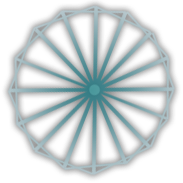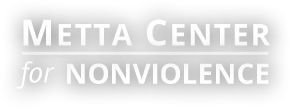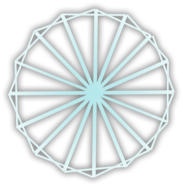Stephanie Steiner
Forum Replies Created
-
AuthorPosts
-
Stephanie Steiner
MemberThank you for sharing these reflections, John! And thank you for this resource recommendation. I did a quick search and found that Gandhi did a “paraphrase” of Ruskin’s work: http://www.mkgandhi.org/ebks/untothislast.pdf
For those interested, you can also find a full text of “Unto this Last” by searching for it.
I related very much to what you said about renunciation vs. acquisition, especially through books (says she who sits in a room surrounded by 3 bookshelves 🙂 I certainly believe we can embetter ourselves through study – hence, teaching this course 🙂 But I fully agree with you that at times we are took quick to look outside ourselves for the answers when they were within all along.
Regarding Gandhi the Man, I believe this was exactly Easwaran’s goal in writing this book – to demonstrate that Gandhi went through significant personal transformation to become the Mahatma, and that this is available to each of us if we put our time and effort and dedication to it. Certainly, it requires discipline. But it is helpful to remind ourselves that it is possible!
Stephanie Steiner
MemberI’m glad to hear that you all benefited from watching the movie, whether you were watching it again or if it was the first time! Indeed, reading your comments I felt like I was watching it yet again. Jean, you did a great job of summarizing the different instances of constructive programme, obstructive programme and heart unity. It’s interesting to see what you all pulled from the film and took away, and as both John and Jean noted, it’s hard to imagine how difficult it would have been to choose the moments of Gandhi’s life to show!
John, you bring up an interesting point about Tolstoy – thank you for addressing that, and thank you for sharing the letter! I will have to ask Michael about the omission.
Marissa – great list of Gandhi quotes! I find it’s really helpful to be able to quote Gandhi offhand. There’s rarely a moment in life when something he said doesn’t have striking relevance, and a lesson to teach us!
You also mentioned how blessed we are to be able to learn from him – and we will continue to do so, especially in the coming weeks as we explore Gandhi the Man and the podcast series. In fact, in one of the podcasts this upcoming week, Michael talks about how we don’t need “another Gandhi,” because we haven’t fully learned from the first one! 🙂
Thank you all for your sharing! His life really was his message, wasn’t it?
StephanieStephanie Steiner
MemberReally interesting Anna – thank you for posting!
Stephanie Steiner
MemberJames O’Dea on how Peace Ambassadors should respond to Syria:
I’d like to note that “put pressure on your government” is at the top of the list. Even though we are all feeling frustrated and powerless, we need to try to use this channel of putting pressure on the government as much as possible. Call your reps, sign petitions, do whatever you can to make your opposition to intervention known. My aunt (who I talked about on the call) said, in regards to the Sunday talk shows, “A Democratic Strategist, whom I respect, states this as a revolutionary moment, seeing this issue as a confrontation between the American people and the rulers in Washington.”
Let’s keep pushing for change in every way that we can 🙂
Stephanie Steiner
MemberCharlie Rose of PBS is interviewing Assad on Monday at 9pm:
http://www.pbs.org/about/news/archive/2013/charlie-rose-interviews-bashar-al-assad/Stephanie Steiner
MemberWow, wonderful stories everyone! I second what Kelly said – Paul, the story you shared about the soldier and your interaction with him after the film was really powerful. We can all really learn from this story, as it sounds like it all comes back to the way the relationship started – with you trying to empathize with him and learn from him, while maintaining that you had a different worldview; rather than starting out trying to change him, or in a very oppositional/confrontational way. This is such an important point to keep in mind.
Like you, Paul, something that I am working on is to speak up when I disagree. Likewise, I empathize easily, but also may shy away from fully voicing my opinion when dealing with confrontation. It’s an area of growth.
Several of you mentioned the fluency of NVC language to be a challenge, and also having friends/family members ask “are you doing NVC on me again?” I can also relate 🙂 I think with NVC or compassionate communication, or communication from a nonviolence perspective, it is more about the worldview that you are entering the conversation with than the specific process or terminology that you use. I think Marshall Rosenberg even talks about this is his book – that it’s less about the specific steps and more about your consciousness.
From a nonviolence perspective, I think the key is to have the understanding of unity in mind, and the intention that, through the conversation, you can come closer together.
Great ideas and stories – thank you all so much for sharing!
StephanieAugust 8, 2013 at 3:31 pm in reply to: Week 6: Spiritual Practice – Cultivating Inner Strength #11289Stephanie Steiner
MemberThank you all so much for these deep, heartfelt reflections and sharing on your spiritual practice. It is wonderful to hear that this lesson was useful for many of you, as it helped to connect what you are already doing in your spiritual practice to your practice and study of nonviolence.
A little about my spiritual practice: I was raised Presbyterian but drifted away from the church as a teenager. As a young adult I discovered yoga and the key spiritual teachings of yoga, especially from the Yoga Sutras and Bhagavad Gita, continue to be an important part of my practice. Through yoga I also discovered mantra which initially didn’t resonate, but I have found it to be a very helpful practice and have been trying to use it more regularly. Around that same time, I started reading the teachings of Thich Nhat Hanh, who I consider to be one of my primary teachers (I will have the opportunity to attend one of his retreats in October in California, which will be my second retreat with him). I actually discovered passage meditation and Easwaran’s teachings while in the Peace Corps, and have been rediscovering them since I have been working at Metta. Like John, I’ll be attending a 1-day retreat in my area in September. And like Marissa, my spirituality is fluid and includes practices from different traditions.
Reading all of your stories helps to remind me of the importance of daily practice. Even when we practice alone, it’s helpful to know that there are others practicing somewhere else in the world. Thank you all so much for sharing!
In peace and solidarity,
Stephanie
Stephanie Steiner
MemberGreat insights everyone – thank you so much for sharing! There is so much that we can learn from each other. You all have such a diverse array of strengths – they are worth celebrating! As I read them, I imagine all of these strengths uniting through the roadmap, the various projects that fit under the umbrella of creating a new story, a higher vision of humanity, a peaceful and nonviolent world.
It seemed like taking too much on and, like Kelly said, getting easily bored with projects resonated with many of you. I, too, have a tendency to take on too much, and like John, risk getting burned out. It is a weakness I’m aware of, and yet is a lesson I haven’t fully learned to work with yet. But it’s a refinement process 🙂
Jean, I second Anna’s comment about your articulateness! 🙂
The issue of being able to talk with people about these issues who don’t necessarily agree with us is a very important one – it’s really something all of us need to be able to do. Like Jean, I’m not always confident in my ability to do this, but it’s something we can continuously be working on, and something that I hope this course will help a lot with!
I think reading Search for a Nonviolent Future will help to this end. Also, Metta has a page of commonly posed objections:
http://archives.mettacenter.org/nonviolence/commonly-posed-objections/
Anna and Marissa both mentioned how our emotions can be a challenge. I hope the week 6 material on spiritual practice can help to this effect. I have definitely found in my own practice that meditation has helped me so much in being more aware of my emotions and being able to sit with them and not react. Again, a work in progress – but that’s why they call it practice, not perfect!
Thank you all so much for your valuable contributions!
Stephanie
Stephanie Steiner
MemberAgreed, Kelly! And if there were any doubts about the food system’s interconnections with the military-industrial complex, check out this article on Monsanto’s connections with Blackwater, the world’s largest mercenary army: http://www.popularresistance.org/monsanto-gearing-up-for-war-against-food-justice-activists/
Stephanie Steiner
MemberWow – again, it is so inspiring to read all your posts! 🙂
It’s interesting to see that so many of you are interested in food issues. I, too, am passionate about the connections between food, peace, and nonviolence, so much so that I have a blog that I co-author with a friend called PeaceMeal: Cultivating Peace Through Food (we’ve both been busy with other things lately, so we haven’t been posting much recently, but even if you read the archives you would get the main idea).
When we study constructive programme in Part 2, we will get more into this, but I wanted to bring it up now since I think it’s relevant. In constructive programme we talk about a stealth issue, which is an issue that will be underestimated by the opposition before it is too late. The salt issue in India would be a good example of this. On a related note, a keystone issue could weaken the whole system if it is successful, as it significantly undermine’s the opposition’s “pillars of support.”
I wonder: could the food movement could be a keystone issue? Does it undermine the war system? At first glance, perhaps no…but I am sure if you look deeply, the same people who profit heavily from the military-industrial complex are also profiting or in close collaboration with those who profit from the industrial agriculture industry. Not to mention, Monsanto itself produced Agent Orange and other products that were directly used in war, in addition to producing so much of the world’s food supply). I imagine that if we look deeply, the food system and military-industrial system are deeply intertwined, so the question is, could a movement towards a new food system that promotes peace, health, wellness, and equality result in larger shifts…
Then we had the recent “March Against Monsanto” protests – did any of you participate in your respective cities? I went to the march in San Diego, and was amazed at the turnout, which was much larger than other peace protests and economic protests that I’ve been to here. I think the food issue, more than other issues, has the potential to unite large numbers of people – food affects everyone! At the same time, I think there is a lot to be done in terms of raising consciousness around the deeper issues – for example, the march was largely inspired by the issue of GMO labeling. Meanwhile, the march went through neighborhoods where there were a lot of homeless individuals, people who do not have the luxury to consider GMO labeling because they are just concerned with getting enough to eat on any given day. This isn’t to say I don’t think GMO labeling is important – but what I am saying is that we need to be marching for (and better yet, creating and constructing!) a world that promotes healthy food for all.
In any case, this is “food for thought”…I’d love to hear what you think in terms of the potential for the food movement to contribute to a nonviolent and peaceful world.
I’m delighted to hear that the roadmap has resonated with many of you and that you are finding your respective places in it – and knowing that we are all working together to create a better world!
Stephanie Steiner
MemberHi all,
It is so incredibly inspiring to hear about your locations on the roadmap and where you want to go with it! I feel a sense of hope and excitement that this tool resonates with you as a way to find your place in the nonviolence movement. And if you didn’t find your place yet, don’t worry! I am confident that by the end of the certificate program, everyone will have found their “home.” We will revisit Roadmap in Part 3 of the course (and I highly encourage you to follow John’s lead and print it out to stare at – I do the same 🙂
I’m actually up at the Metta office in Petaluma (normally I work from my apartment in San Diego), and I have word that the compass tool should be going live any day now – we are just waiting for the designer to give us the final version. I will definitely keep you posted when I hear more!
Sydney, your comment about the Roadmap helping you to see your work in the bigger picture is exactly what the roadmap was designed for – to give all of these wonderful movements and initiatives and efforts a common ground to work from and towards. We are all aspiring to work for a better world, and we are much more effective when we can work together on this common goal!
I will write more after the board meeting this weekend- your encouraging words give me lots of inspiration for what I’ll be sharing with Metta’s board!
-Stephanie
Stephanie Steiner
MemberThank you all so much for these immense sharings.
Jean, my heart goes out to you and your family in this difficult time. Indeed, it certainly illustrates our interconnection – our interbeing, as Thich Nhat Hanh would say – when our loved ones are suffering. I love that you were able to do your own “home-work” very literally, by applying the week’s themes to what is going on in your life.
Gandhi’s autobiography, after all, was called My Experiments With Truth, and I definitely encourage each of you to see this course as an opportunity for your own “experiments with truth” (though I can see from your responses that you are all already doing this :). Our lives are really the laboratories for nonviolence. It is important to understand nonviolence at an intellectual level, but it is when we apply it that transformation happens.
All of your answer’s to the question of life’s purpose reminds me of another Gandhi quote, “My life is my message.” Paul, John and Jean, you all wrote very clear answers to the meaning of life (which, though different, are interrelated and all connected to nonviolence). Once we are clear on life’s larger purpose and our own purpose within it, we can keep asking ourselves if our actions and intentions are aligned with this purpose.
I find this can be particularly helpful when taking on new projects or when someone asks us to do something. Checking in to see if a new project or commitment aligns with our purpose helps us to direct our energy in positive and constructive ways.
Thank you so much for sharing your thoughts!
And before I close, it wouldn’t be fair to not share with you my own purpose, which I believe, in short, is to cultivate peace. Here is the daily intention I set, which tries to encapsulate this purpose (nonviolence, of course, being the means, the foundation):
May I cultivate peace, love, joy, and compassion in all aspects of my life.
May my efforts come from love.
May my efforts be of service.
May my efforts be to the benefit of all beings.With love,
StephanieStephanie Steiner
MemberIt is very inspiring to me to read your takeaways, reflections, and questions! I really want to thank all of you for sharing your thoughts, and for your committed studies this week (I can tell from your posts that you spent a lot of time with the material, both in mind and heart).
I wanted to highlight the questions that some of you posted for further discussion and reflection:
How can I find more ways to share the New Story in my everyday life?
How can we remind ourselves and one another of just who we are?
How can I deal with the challenges of the aspects of the nonviolence pledge?Several of you noted the difficulty in limiting exposure to mass media, and I think this is a common struggle for all of us – whether you watch TV or not, it is very hard not to be exposed. But don’t feel like you need to give it all up at once – start small, such as with one day free from media and electronics per week (even once a month is a good start!). Think of it as an experiment (Gandhi, after all, called his life “experiments in truth”) – and not one you have to get “right” immediately. With family members who might not be on the same page, even asking them to do an activity together that doesn’t involve media (go for a hike instead of watching a movie, for example), is a great place to start.
Like many of you, the higher image of a human being – of who we are – definitely resonates with me, and was really my motivation for coming to peace and nonviolence studies. I remember thinking, “We can do better than this!” We are inherently creative, have made amazing progress in some ways, and we have the vast potential to be compassionate and loving. We have a higher potential – a much higher one than is often portrayed in the media.
But as John noted, the media can be part of the solution, and as Jean noted, telling the stories of nonviolence helps to remind us of who we are. There are many media outlets emerging that share these stories, and listening to the stories they tell can give us strength and inspiration as nonviolence practitioners.
I deeply appreciate each one of your reflections!
Stephanie Steiner
MemberHi Everyone,
It’s so wonderful to read your introductions! Thank you all so much for sharing.
Warren, thank you for taking the brave and courageous initiative to be the first to speak -your vulnerability, honesty, and openness set the stage for others to share in the same way. Thank you 🙂 I also recently joined a Plum Village sangha and definitely resonate with what you say about Thich Nhat Hanh’s teaching being alive for you at the moment. I also really appreciated how you started by asking yourself to describe what you love – I think I will borrow this for future icebreakers/introductions!
John, how interesting it is to hear about your career path and your path to nonviolence. I can only imagine the challenges you must face to apply nonviolence in the Customs and Border Patrol. It makes me think about how we need agents of nonviolence everywhere – we definitely need people like you working in that department! I look forward to hearing more about these intersections throughout the course, and hope that this course leads you to some new strategies for applying nonviolence in your life and work.
Paul, it’s great to hear that we have a participant from the UK! When you described nonviolence as “the means and ends to all these issues,” it certainly resonated with me and what we at the Metta Center are trying to do. We will definitely be exploring this more throughout the course.
It’s also interesting to see the unifying threads of NVC, Quakers, meditation, aikido.
Thank you so much for introducing yourselves!
Stephanie
Stephanie Steiner
MemberI am Stephanie Knox Cubbon, and I currently live in San Diego, California. I am the online education coordinator for the Metta Center and your facilitator for this course (my bio on the Metta site is here). I received my master of arts in peace education from the University for Peace in Costa Rica, and subsequently developed a peace education teacher professional development program for Teachers Without Borders (you can find out more about that here). Teaching peace and nonviolence is truly my passion, so I am very excited to be working on this course with all of you!In terms of my path to nonviolence, I first came to understand nonviolence through my yoga practice (I am also a certified yoga teacher). In my master’s program, though, I would say that we did not receive adequate study of nonviolence, and it was really only through starting to collaborate with the Metta Center in 2010 that I began an in-depth study of nonviolence. It is amazing to me that even in a peace education master’s program that the study of nonviolence can be lacking – let alone in public and higher education. I see a great need for studying nonviolence, and that’s why I’m here – both to deepen my own studies and understanding of nonviolence, and to make these studies accessible to others with the hope that together we can contribute to positive change towards a nonviolent and peaceful world. I very much consider myself to be an “edu-learner” – teaching and learning all the time.In the rest of my time, I can be found hanging out or walking with my Costa Rican dog and English husband, reading, practicing yoga, meditating, cooking, and/or singing 🙂I am here to support you in any way that I can, so don’t hesitate anytime to send me an email and ask questions or share your experience. As this is the first time running this course, we welcome your feedback for how we can improve it, so keep that in mind as you proceed with the course materials.I’ll look forward to getting to know each of you and working with you throughout the course!Warm wishes,Stephanie -
AuthorPosts







